Vegan ube cheese pandesal is absolutely delicious and not to mention very pretty to look at. It’s the modern take on the classic Filipino bread roll. This Filipino bread has been taking over my feed since the COVID-19 lockdown started, and I can see why. These buns have a beautiful deep purple color, filled with cheese and ube jam! It actually makes a good flavor combo because the jam and the bread itself are sweet and together with the saltiness from the cheese — it really balances it out.
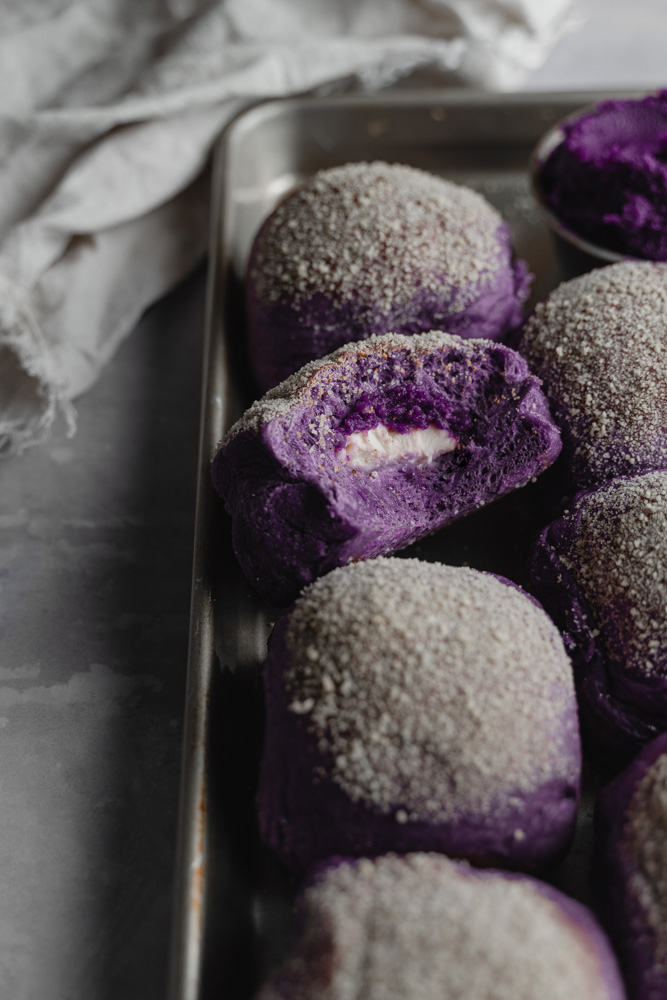
What is ube?
Pronounced as: “OO-BEH”, ube is a purple yam and is a staple ingredient for Filipino desserts. They are usually boiled and mashed and are used a lot in jams or to color sweet treats. It has a mild and sweet flavor, which some have said is a cross between vanilla and pistachio. Another thing, most people confuse it with taro, and the short answer is, no, they are not the same. Taro is often used in savory cooking, while ube is used for sweets.
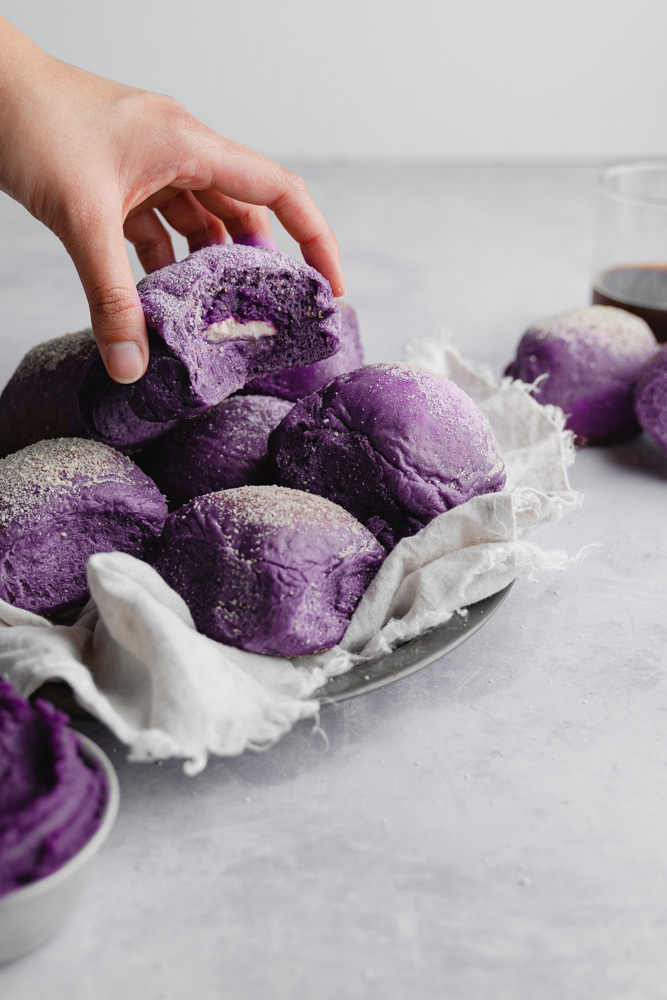
Key ingredients for vegan ube cheese pandesal:
- Ube powder (aka dehydrated purple yam powder) - This alone will give your buns that beautiful purple color and the extra moisture will make them very soft and supple! I bought mine at my local Filipino store. If you can’t find use powder, you can also use fresh purple yam!
- Ube extract - Optional, but highly recommended! Using the ube powder alone will not give you that ube flavor. Ube extract will help give that boost of flavor and give a deeper purple color.
- Vegan cream cheese - For my recipe, I prefer using cream cheese to fill these up. I see these buns as a nice sweet treat, and cream cheese just goes better with sweet than cheddar cheese. Cheddar cheese is just too sharp for this recipe, and I’m not a big fan of it.
- Ube jam (ube halaya) - Adds a touch of sweetness and more use flavor to the buns!
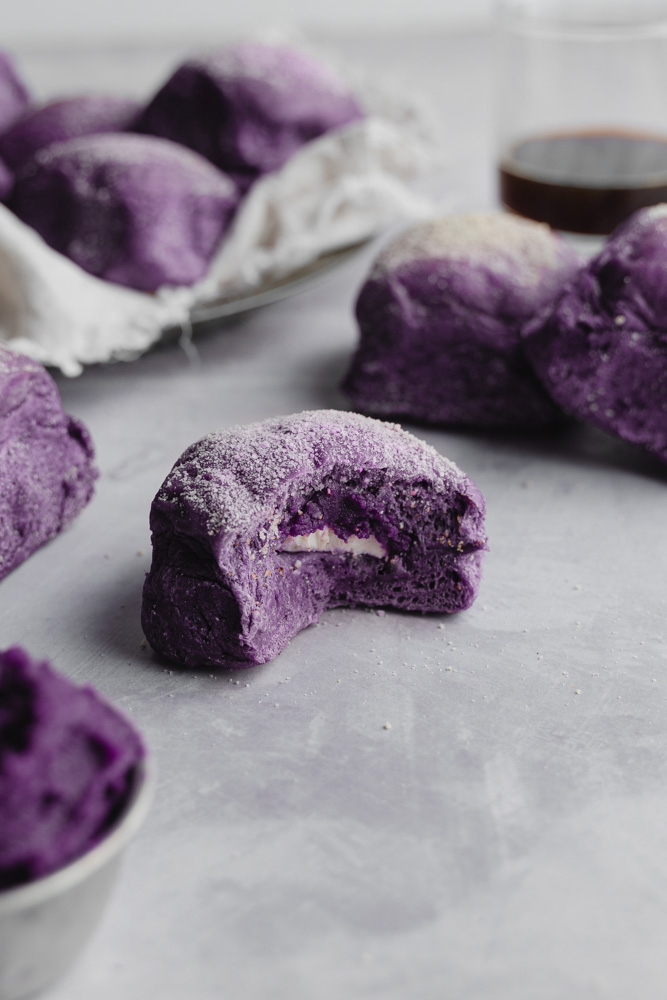
Top tips:
- Measure your flour properly. A common reason baked goods fail is incorrectly measured flour. I always recommend using a scale for accuracy when baking. This greatly improves your chance for success and lessens room for error. My recipes are 100% tested in grams.
- If you’re measuring by cups, avoid scooping the measuring cup directly into the flour. This tends to pack the flour into the cup, resulting in too much flour and a very dense or gummy finished product. Instead, aerate your flour (fluff it with a fork or spoon) and then spoon it into your measuring cups, leveling it with your finger or the back of a butter knife. Keep in mind though, that this method is not guaranteed to be accurate.
- Watch this video from King Arthur on how to properly measure your flour if you don’t have a food scale:
https://www.youtube.com/watch?v=GUSovVHpqsU - Rehydrate your ube powder. To rehydrate your ube powder by heating it up in a saucepan with some hot water. You want it to feel like a mash potato consistency. This adds a bit of moisture to the pandesal and adds a lovely purple color.
- Flattening your pandesal properly. Before you add the filling, you'll have to flatten the dough. To do this, you'll first want to roll out the dough to 3-inches in diameter. Then, flatten the edges about 1-inch more, leaving a lump in the center. Leaving a lump in the center will even out the top and the bottom of the pandesal. If you do not leave a lump in the center, it'll cause the top of the pandesal to be super thin. Which might cause the filling to breakthrough.
- Use ube extract. This just enhances the flavor even more, if you don't want to use it that's fine! You'll just get a little less flavor.
- Where to find ube halaya and ube extract? I found my key ingredients at my local Filipino store! You can most likely find these ingredients at your local Asian market. I don't recommend buying it online because they really jack up the price.

I'm gonna be honest with you, I've never had a real ube cheese pandesal. I took inspiration from what I've seen from other Filipino recipe developers and created my own version. Originally, these are filled with cheddar cheese, however, that flavor combo did not sit well with me. Instead, I decided to fill these up with ube halaya (ube jam) and vegan cream cheese. And let me tell you, it tastes amazing! What’s so great about this vegan ube cheese pandesal is that you don’t need to worry about what kind of spreads to use. It already has its own great sweet and savory filling, so just get your coffee ready and be ready for a great meal!

If you tried this recipe, let me know what you think in the comments below. You can also share it with me on Instagram, just tag @flouredframe. I would love to see your recreations! Happy baking!
If you like this recipe, check these out!
Recipe and photos updated on January 2021.
As an Amazon Associate I earn from qualifying purchases.
📖 Recipe

Vegan Ube Cheese Pandesal
Equipment
- Measuring spoons
- Small saucepan
- Heatproof silicone spatula
- Large bowl
- Damp cloth or bowl covers
- Bench scraper or large knife
- Parchment Paper
- 8x8-inch square baking pan or a regular baking sheet
Ingredients
Dough
- 2 ½ tablespoons Dehydrated ube powder
- ½ cup Hot water
- 160 ml Non-dairy milk (I used soy)
- 1 ½ teaspoon Instant yeast
- 320 g Bread flour
- 68 g Granulated sugar
- 1 teaspoon Salt
- 42 g Vegan butter (softened at room temp)
- 1 tablespoon Ube extract
- 1 container Vegan plain cream cheese (I used Kite Hill)
- Ube jam (Ube Halaya)
Toppings
- ⅓ cup unseasoned panko bread crumbs
Instructions
Prep breadcrumbs
- If your breadcrumbs are chunky, blitz them in the blender or in a food processor until you get a fine texture. Set aside until ready to use.
Make the dough
- In a small saucepan, combine the hot water and the dehydrated ube powder. Allow the dehydrated ube powder to sit in the hot water for 15 minutes. Then place over medium heat, and stir the mixture together until all the dehydrated ube powder has been properly rehydrated. It should be smooth and look like mashed potatoes. Remove from heat and allow it to cool to room temperature.
- In the bowl of a stand mixer, combine the salt, bread flour, sugar, and instant yeast. Mix until well combined.
- Next add the softened butter, ube extract, and the rehydrated ube from earlier. Knead with the dough hook attachment on medium-low speed for 10 minutes until it forms one cohesive dough. You’ll know when your dough is fully kneaded when it springs back when you lightly press down on it.
- Shape the dough into a ball and transfer to a lightly oiled bowl and cover. Let the dough rise in a warm spot for 1 hour, or until doubled in size.
- While you wait, prepare a square pan by lining it with parchment paper.
Shape and fill
- When your dough is done rising, punch down the dough and measure out 9 equally sized pieces. Cover with a damp cloth while we work on one piece of dough at a time. Flatten the dough with a rolling pin, about 3 inches in diameter. Then flatten out the edges about 1-inch more, leaving a lump in the center.
- Scoop out about a tablespoon of ube jam and spread it over the dough, leaving the edges bare. Then add a tablespoon of cream cheese and place it over the jam. Pull up the edges of the dough to cover the filling, and pinch the seams together. Roll the tops of each dough ball with breadcrumbs, and place them on the prepared pan. Repeat for the rest of the dough.
- Once you're done filling each dough ball, cover them with warm damp cloth and allow them to rise for 30-40 minutes or until doubled in size. While you wait, preheat the oven to 350° Fahrenheit.
- When the dough has doubled remove the cloth and bake for 20-25 minutes or until the tops turn slightly dark, but not burnt.
- Remove the ube pandesal from the oven, allow it to cool in the pan for 10 minutes. Transfer to a wire rack to cool completely. Serve the rolls warm or at room temperature, enjoy!
Notes
- Measure your flour properly. I test my recipes, 100% in grams. A common reason baked goods fail is incorrectly measured flour. I always recommend using a scale for accuracy when baking. This greatly improves your chance for success and lessens room for error.
- Vegan cream cheese options: Kite Hill is my favorite brand to use for baking, they always come out perfect. Do not use Violife as it completely melts when it is heated and doesn't keep it's structure. I hear some good things about Miyoko's vegan cream cheese as well!
- Instead of making my ube jam recipe, you can buy it in-store. However, keep in mind that most of them do contain dairy. There are a handful that are vegan friendly. Just be sure to read the ingredients list!
- These rolls will last for a week, keep leftovers in an airtight container. Reheat in the microwave, oven, or toaster oven.

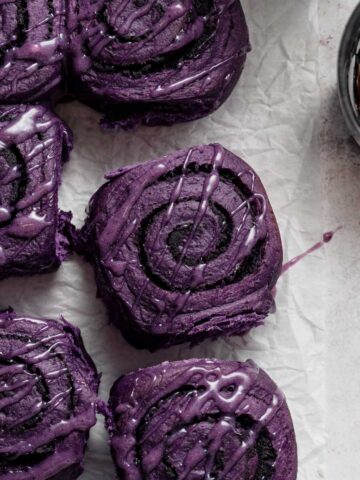
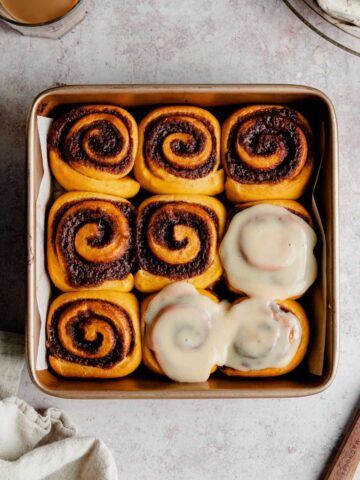

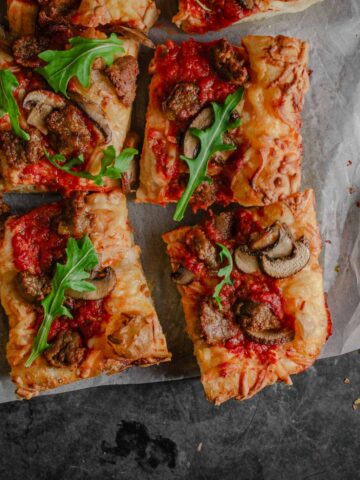
Kate says
What are the measurements for all purpose flour and instant yeast?
Floured Frame says
Hello!
All the measurements are provided in the recipe card above, but to answer your question, they are:
1 ½ teaspoon – active dry yeast
2 ½ cup (320g) – bread flour
They are one-to-one measurements if you want to swap them for instant yeast and all-purpose flour.
oli says
Hi there, i tried it last night, but the bread didn't turn out fluffy hence it's dence. I used 1/3 cup purple yum.
Floured Frame says
Sounds like there could be multiple factors that could have caused it, but my main guess is that you probably added too much flour.
My recipes are always tested in grams, and while I do add cups to the recipe, grams are always my preferred method of measurement.
Avoid scooping the measuring cup directly into the flour. This tends to pack the flour into the cup, resulting in too much flour and a very dense or gummy finished product.
Instead, aerate your flour (fluff it with a fork or spoon) and then spoon it into your measuring cups, leveling it with your finger or the back of a butter knife.
Keep in mind though, that this method is not guaranteed to be accurate.
If you need more help, watch this video from King Arthur on how to properly measure your flour: https://www.youtube.com/watch?v=GUSovVHpqsU
Hope this helps!